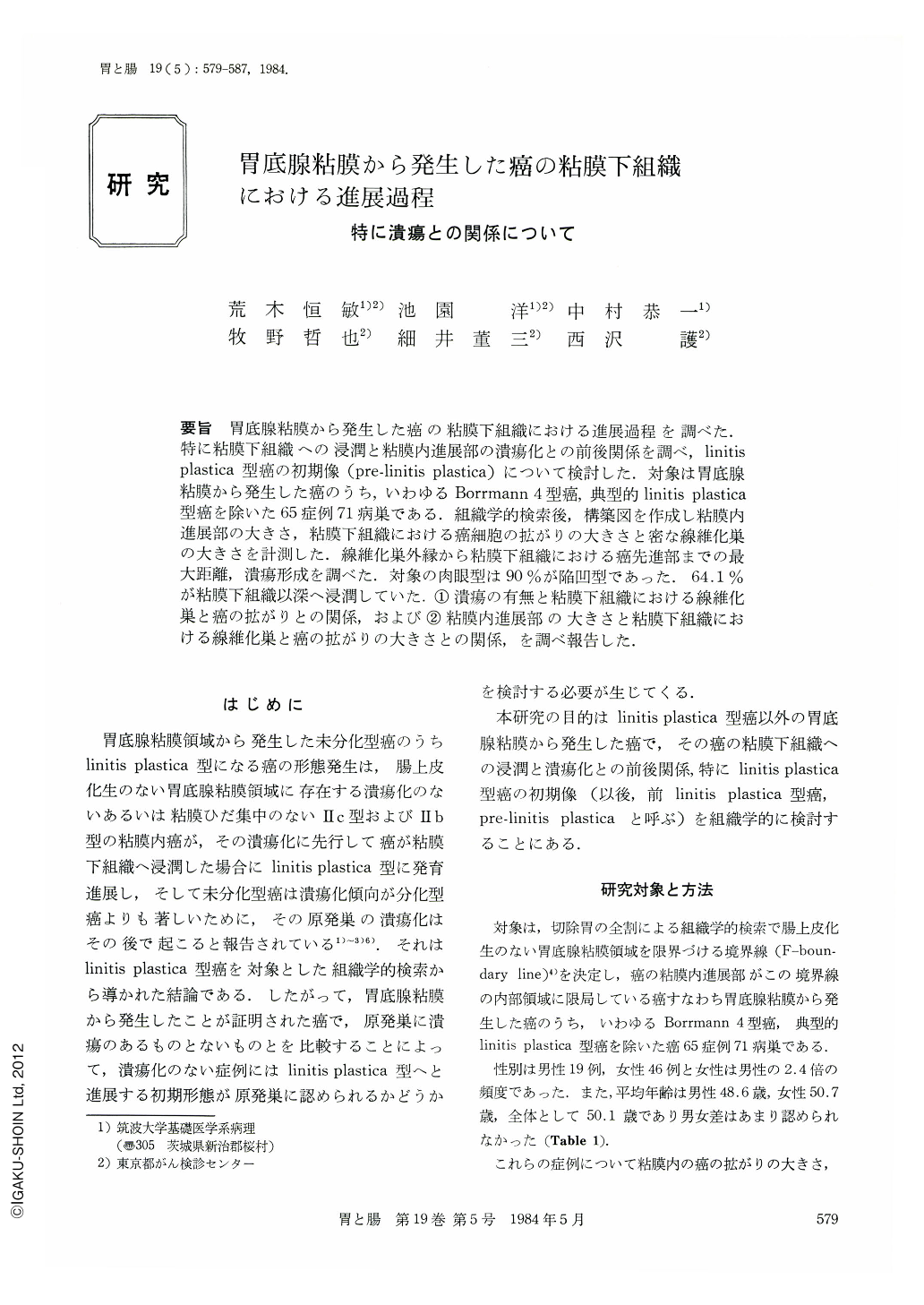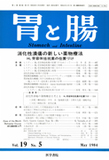Japanese
English
- 有料閲覧
- Abstract 文献概要
- 1ページ目 Look Inside
- サイト内被引用 Cited by
要旨 胃底腺粘膜から発生した癌の粘膜下組織における進展過程を調べた.特に粘膜下組織への浸潤と粘膜内進展部の潰瘍化との前後関係を調べ,linitis plastica型癌の初期像(pre-linitis plastica)について検討した.対象は胃底腺粘膜から発生した癌のうち,いわゆるBorrmann4型癌,典型的linitis plastica型癌を除いた65症例71病巣である,組織学的検索後,構築図を作成し粘膜内進展部の大きさ,粘膜下組織における癌細胞の拡がりの大きさと密な線維化巣の大きさを計測した.線維化巣外縁から粘膜下組織における癌先進部までの最大距離,潰瘍形成を調べた.対象の肉眼型は90%が陥凹型であった.64.1%が粘膜下組織以深へ浸潤していた.①潰瘍の有無と粘膜下組織における線維化巣と癌の拡がりとの関係,および②粘膜内進展部の大きさと粘膜下組織における線維化巣と癌の拡がりの大きさとの関係,を調べ報告した。
The process of submucosal invasion of gastric cancer cells originated from the fundic gland mucosa was studied. Especially, the relationship of sequence between cancer infiltration to the submucosa and ulcerformation of primary lesion was examined, and discussed about incipient phase of linitis plastica type of carcinoma (pre-linitis plastica).
Subjects were 65 cases, 71 foci of carcinomas originated from the fundic gland mucosa except so-called Borrmann 4 type carcinoma and typical linitis plastica type carcinoma. The size of mucosal spread of cancer (Rm, Sm), submucosal invasion of cancer (Rsm, Ssm) and massive submucosal fibrosis (Rf, Sf) was measured (Fig. 1). The maximum deviation of submucosal cancer cells from the submucosal fibrosis was prescribed as Dmax. Ulceration grade Ⅱ, Ⅲ and Ⅳ were regarded as ulcer-formation (Ul (+)).
Ninety per cent (64/71) of all the macroscopic appearance was depressed type. Sixty four per cent (41/64, except 7 microcarcinomas) was already infiltrated the submucosal layer (Table 2).
(1) The relationship between the ulceration of primary lesion and deviation of submucosal cancer cells from submucosal fibrosis.
In 41 foci, except the carcinoma limited to the mucosa, ulcerative cases were 35 foci (85%) and non-ulcerative cases were 6 foci (15%) (Table 3). In 35 foci of ulcerative group, 24 foci (69%/, 24/35) were Dmax (-), and its average was 0.8 cm. Submucosal cancer cells of ulcerative group had tendency to exist in submucosal fibrosis (Fig. 2). Five foci of non-ulcerative group (83%, 5/6) were Dmax (+), and its average was 3.1 cm.
(2) The relationship between the size of mucosal spread of cancer and the size of submucosal fibrosis and submucosal invasion of cancer.
The average of ulcerative group 35 foci were Sm: 6.7 cm2, Ssm: 3.5 cm2, Sf: 4.0 cm2, Ssm/Sf: 0.9, and the average of non-ulcerative group 6 foci were Sm: 3.6 cm2, Ssm: 10. 6 cm2, Sf: 3.4 cm2, Ssm/Sf: 11.0 (Table 4). As compared with ulcerative group, non-ulcerative group's Ssm was very big and moreover Sf which was small in spite of small Sm.
The relationship of sequence between cancer infiltration to the submucosa and ulcer-formation of primary lesion was presumed as follow; cancer infiltration preceded the ulcer-formation in the non-ulcerative group. But in the ulcerative group, it regarded that ulcer-formation preceded the cancer infiltration to submucosal layer, or whatever the cancer infiltration preceded the ulcer-formation it regarded that the two matters occurred within a short time.
Because ulcerative group's Ssm was small and Sm was big, and submucosal cancer cells had tendency to exist in the submucosal fibrosis.
So carcinoma that has no ulceration in the primary lesion, except carcinoma limited to the mucosa, originated from the fundic gland mucosa is regarded as the incipient phase of linitis plastica type carcinoma (pre-linitis plastica).

Copyright © 1984, Igaku-Shoin Ltd. All rights reserved.


